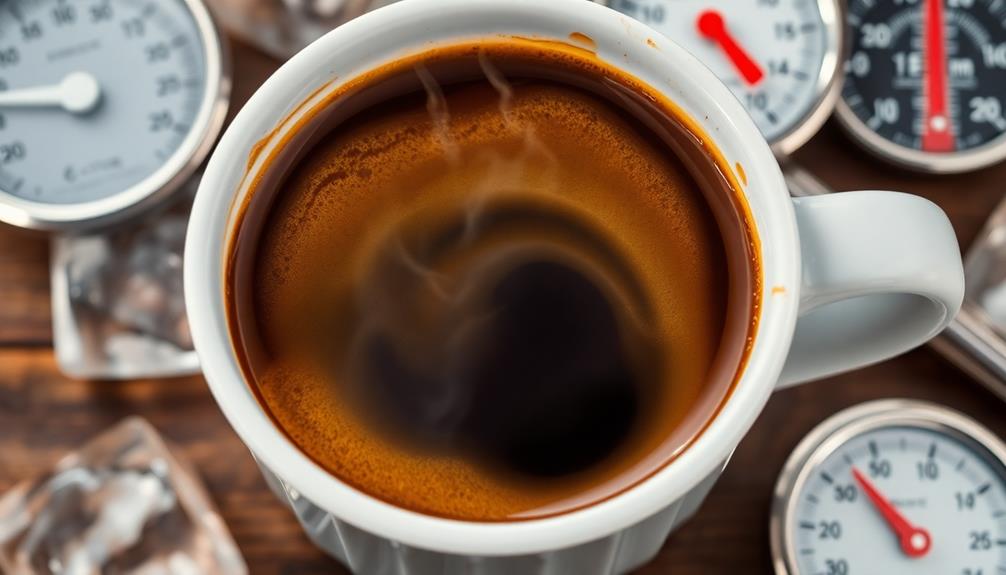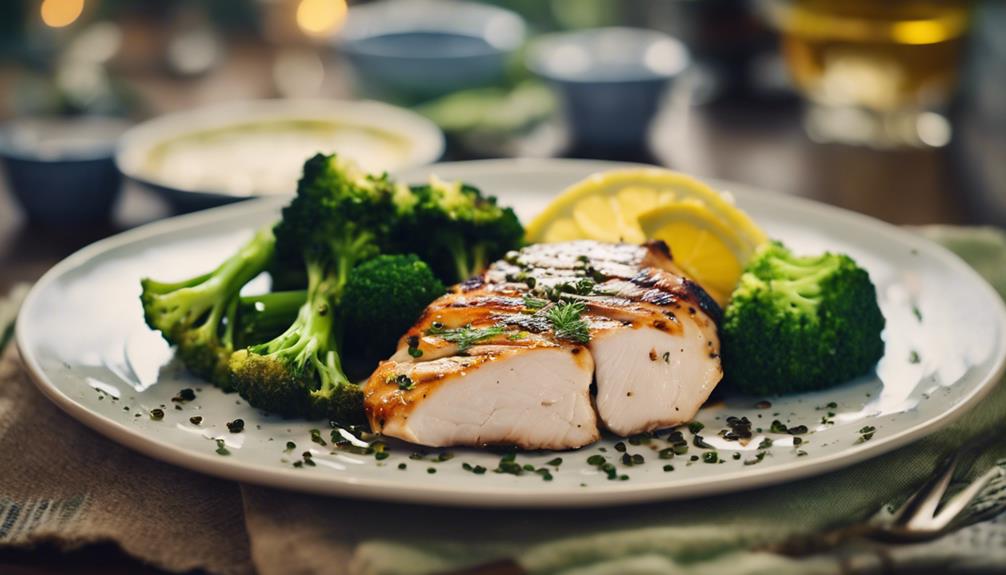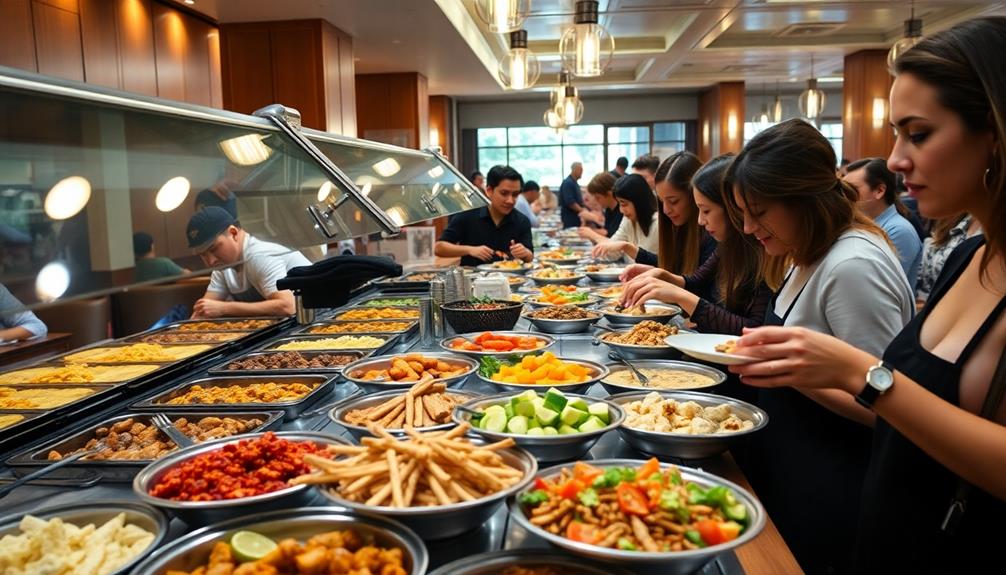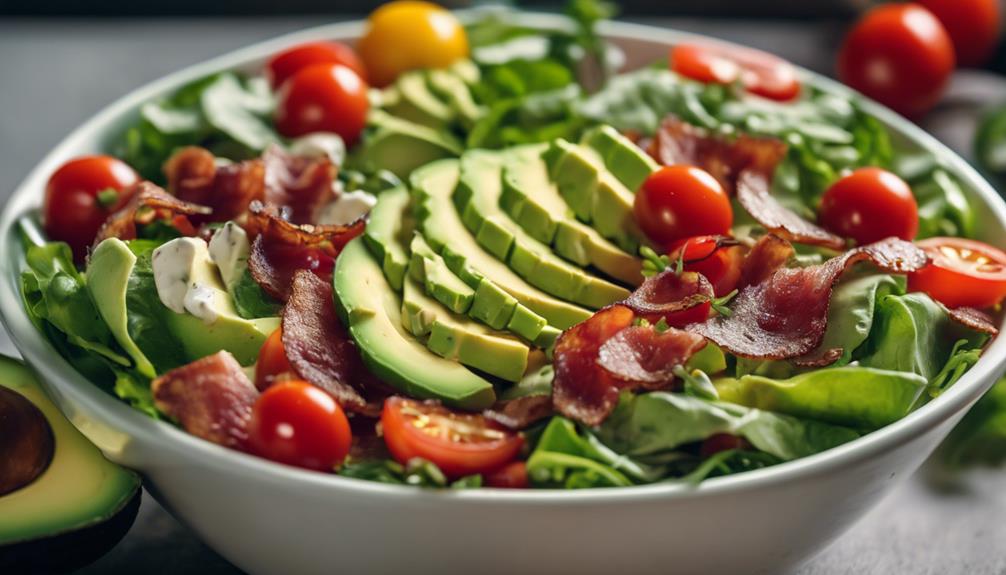Temperature is key in determining your coffee's flavor. If you brew between 195°F and 205°F, you get ideal extraction, but lower temperatures can make coffee taste sour, while higher ones lead to bitterness. When serving, aim for 125°F to 140°F for the best flavor experience. Cool coffee reveals sweetness and complex flavors, peaking at around 42°F. If you enjoy cold brews, the lower brewing temperatures help minimize bitterness. Managing temperature throughout brewing and serving guarantees a balanced cup. Curious about the best methods to enhance your coffee experience? There's much more to uncover!
Key Takeaways
- Brewing coffee at 195°F to 205°F optimizes extraction, while lower or higher temperatures can lead to sourness or bitterness, respectively.
- Serving coffee between 125°F to 140°F enhances flavor, with peak aroma between 140°F and 158°F.
- Cooling coffee triggers chemical reactions that improve flavor, with sweetness peaking around 42°F to 44°F.
- Employing proper chilling techniques, like cold brew or ice mixing, can maintain flavor integrity while minimizing bitterness.
- Consistent temperature control and equipment calibration are essential for achieving a balanced and enjoyable coffee experience.
Brewing Temperature Impact
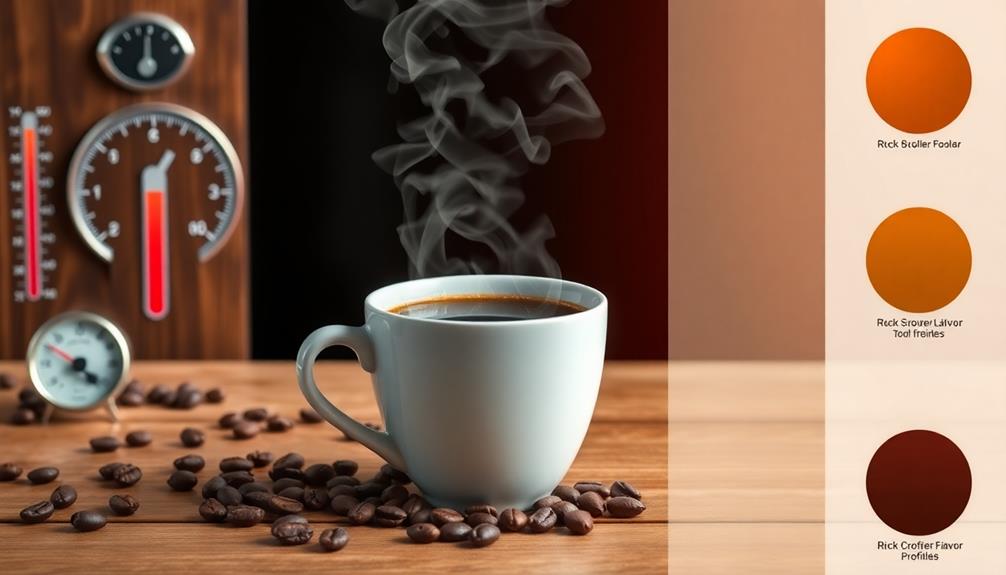
When it comes to brewing coffee, temperature plays an essential role in the flavor you'll experience. The ideal brewing temperature ranges between 195°F and 205°F (90°C to 96°C), which optimizes flavor extraction from your coffee grounds.
If you brew at lower temperatures, below 195°F, you risk under-extraction, leading to a sour taste and lacking body in your cup. Conversely, brewing at higher temperatures can cause over-extraction, releasing bitter compounds that create a harsh flavor profile.
For lighter roasts, slightly higher brewing temperatures work best, allowing for faster extraction and highlighting the delicate coffee flavors. Notably, just as the right temperature is essential for coffee, culinary traditions around the world showcase how temperature influences the flavors of various dishes.
On the other hand, darker roasts benefit from lower temperatures to prevent bitterness. Achieving a balanced cup hinges on your ability to maintain consistent brewing temperatures within this range.
If you want to enjoy a harmonious blend of flavors, remember that both under-extraction and over-extraction can ruin your coffee experience. By paying attention to brewing temperature, you can craft a cup that showcases the unique characteristics of the beans you've chosen, ensuring you savor every sip.
Serving Temperature Considerations
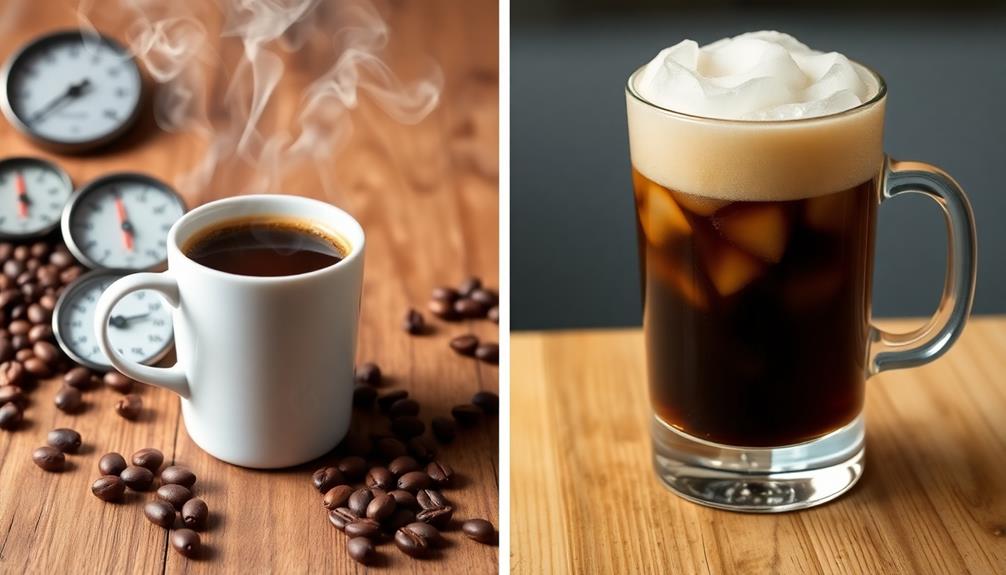
Brewing coffee at the right temperature sets the stage, but serving it at the proper temperature is just as important for enjoying its full flavor potential. The ideal serving temperature for coffee lies between 125°F and 140°F (52°C to 60°C). Within this range, you'll experience enhanced mouthfeel and flavor perception, making each sip enjoyable.
Just as with a well-prepared dish like Nettle and Potato Soup that highlights fresh ingredients, the temperature at which coffee is served can elevate its flavor experience.
Be cautious, though; consuming coffee above 185°F (85°C) can scald your tongue and diminish your overall tasting experience. When coffee is served between 140°F and 158°F (60°C to 70°C), aroma levels peak, and various flavor profiles become more pronounced.
On the other hand, as coffee cools to around 107°F (42°C), bitterness diminishes, allowing sweeter and more nuanced flavors to shine through. If it drops below 122°F (50°C), you'll notice significant changes in flavor and aroma, with sweetness becoming more prominent and bitterness fading away.
Coffee Chilling Techniques

There are several effective techniques for chilling coffee that can help you maintain its rich flavors without sacrificing quality. One popular method is to create a coffee concentrate. By brewing a triple strength coffee concentrate, you can mix it with ice without losing flavor integrity; this helps prevent dilution while allowing your iced coffee to shine.
Similarly, just as Red-Braised Pork Belly relies on careful preparation to enhance its flavors, so too does iced coffee benefit from thoughtful chilling methods.
Cold brew is another fantastic option, as it's brewed at lower temperatures, which minimizes bitterness and creates a smooth flavor profile. When stored properly under 40°F (4°C), cold brew retains its ideal flavor, avoiding the harshness often associated with traditional hot brewing methods.
If you prefer hot coffee, consider mixing it with your favorite syrups or creams before pouring it over ice. This technique enhances the overall flavor while mitigating the dilution that comes from melting ice.
Temperature's Role in Flavor

Chilling coffee can enhance its flavors, but understanding how temperature influences taste is just as important. The temperature at which you brew and serve your coffee directly impacts the extraction of flavor compounds from the beans. Here are three key points to keep in mind:
1. Best Brewing Range: Stick to a brewing temperature between 195°F to 205°F (90°C to 96°C) for optimal flavor extraction. This range helps release the desired aromas and minimizes bitterness.
Similar to how the perfect temperature can elevate a Loaded Baked Potato, brewing coffee at the right heat can greatly enhance its taste.
2. Flavor Evolution: As your coffee cools, the flavor profile shifts. At around 122°F (50°C), sweetness and fruitiness become more pronounced, while bitterness greatly decreases around 107°F (42°C).
3. Aroma Peaks: The best aroma experience occurs between 140°F to 158°F (60°C to 70°C). However, higher temperatures can mask delicate flavors due to overwhelming bitterness.
Ideal Drinking Temperature
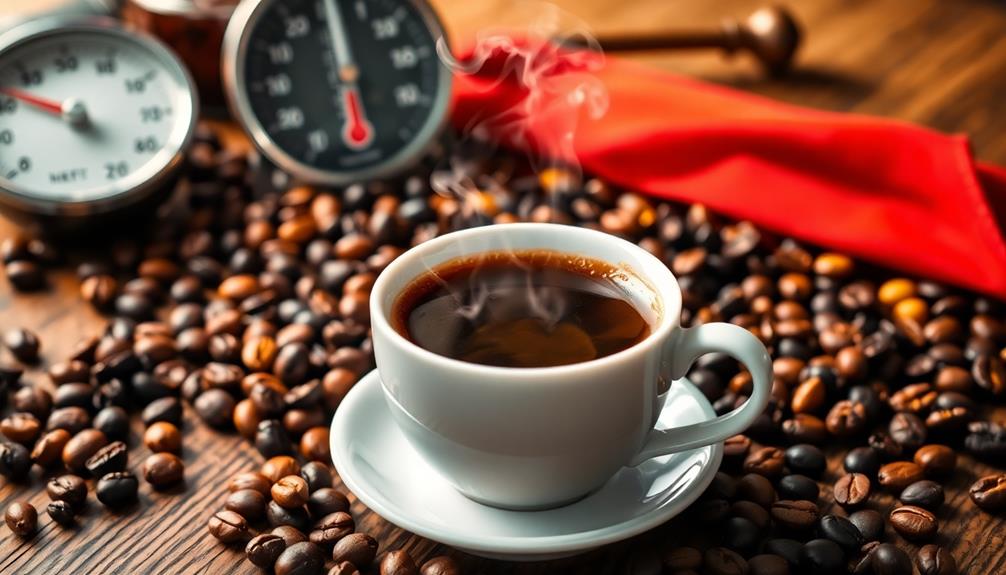
Finding the right temperature to enjoy your coffee can greatly enhance your tasting experience. The National Coffee Association recommends an ideal drinking temperature between 179°F and 185°F (82°C to 85°C) for optimal flavor enjoyment. At this range, you can appreciate the intricate coffee profile without risking scalding your tongue, which would mask those delightful flavors.
Many people enjoy pairing their coffee with a sweet treat like Rasgulla, which can be a delightful complement to the rich flavors of coffee.
When you sip your coffee, taking small sips or slurping can help prevent burns while simultaneously allowing for the release of aroma levels that peak between 140°F and 158°F (60°C to 70°C). This temperature range is essential for fully experiencing the complex flavors in your cup. If your coffee is too hot, you might miss out on these subtleties.
If you prefer a cooler beverage, consider adding cold milk or cream, which quickly reduces the temperature without sacrificing flavor. This method guarantees you still enjoy the nuances of your drink while keeping it at a safe, enjoyable temperature.
Effects of Cooling on Flavor

As your coffee cools, you'll notice a fascinating transformation in its flavor profile. The drop in temperature triggers chemical reactions that enhance the coffee's sweetness and reveal distinct notes. This change in flavor can be likened to the evolution of Brazilian dishes, where traditional flavors come to life through varying temperatures and cooking techniques.
You might find that some flavors become more prominent, while others fade into the background.
Here are three key effects of cooling on coffee flavor:
- Sweetness Peaks: As the temperature drops to around 42°F to 44°F (5.5°C to 6.5°C), you'll experience a peak in sweetness, making your coffee taste richer and more enjoyable.
- Bitterness Decreases: Lower temperatures reduce bitterness, allowing complex flavors to shine through. Between 38°F and 41°F (3.5°C to 5°C), you can savor the subtleties that might otherwise be masked.
- Aroma and Acidity: While aroma detection diminishes below 47°F (8°C), acidity becomes more pronounced, especially in African coffee blends. This vibrancy adds an exciting layer to the overall flavor experience.
Controlling Coffee Temperature
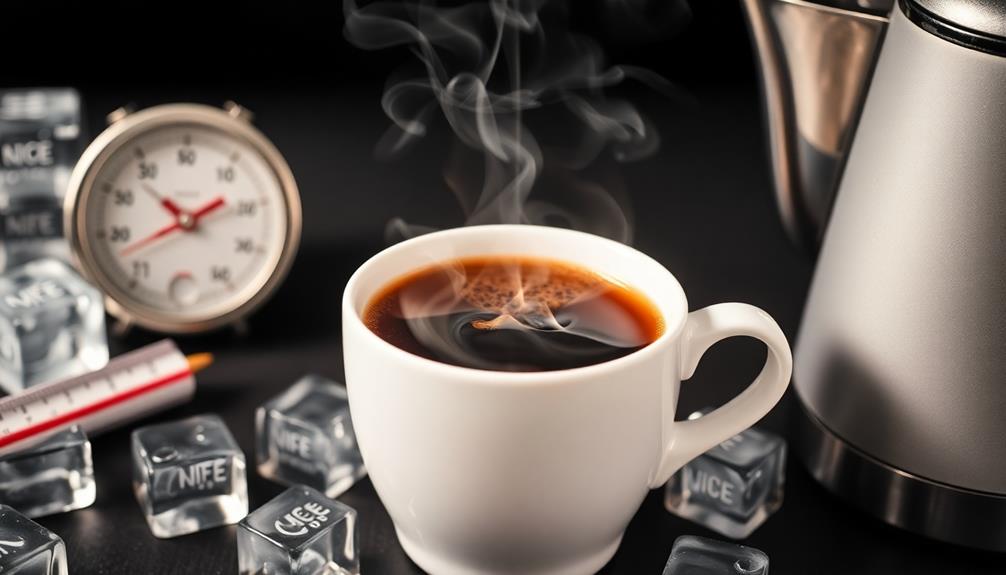
To brew the best cup of coffee, controlling the temperature is crucial, since it directly impacts flavor extraction. The ideal brewing temperature for coffee falls between 195°F and 205°F (90°C to 96°C). This range enhances the extraction of flavors and aromas from the coffee beans, guaranteeing a balanced cup.
| Roast Level | Ideal Brewing Temperature | Effects of Temperature |
|---|---|---|
| Light Roasts | Higher Temperatures | Enhanced sweetness and complexity |
| Medium Roasts | Ideal Range (195°F-205°F) | Balanced flavors and aromas |
| Dark Roasts | Lower Temperatures | Reduced bitterness and astringency |
Maintaining this temperature helps prevent over-extraction, which can lead to bitterness, and under-extraction, causing sourness. For lighter roasts, brewing at slightly higher temperatures brings out more sweetness, while darker roasts benefit from lower temperatures to avoid astringency. Utilizing precision brewing equipment, like electric gooseneck kettles, allows you to maintain that perfect coffee temperature consistently. Regularly calibrating your equipment guarantees that your brewing process stays within the best range, ultimately enhancing your coffee experience.
Exploring Extraction Dynamics

Understanding how temperature affects extraction dynamics is vital for brewing an exceptional cup of coffee. The relationship between water temperature and extraction rates can greatly influence your coffee's flavor profile.
For instance, the same principles that apply to coffee brewing can be seen in the preparation of traditional Italian dishes like Agnolotti, where the cooking temperature and technique markedly impact the final flavor.
Here's what you need to know:
- Temperature Range: The ideal brewing temperature typically falls between 195°F and 205°F. Higher temperatures extract oils and caffeine faster, but they can lead to over-extraction, resulting in unwanted coffee bitterness.
- Roast Type Matters: Lighter roasts thrive at higher temperatures to enhance extraction, while darker roasts require lower temperatures to avoid bitterness that can detract from their unique flavor characteristics.
- Brewing Methods: Different brewing methods utilize water temperature differently. For instance, cold brew compensates for lower temperatures with extended brew times, yielding a sweeter, less bitter flavor profile.
Frequently Asked Questions
What Is the Best Temperature for Coffee Flavor?
To enjoy your coffee at its best, brew it between 195°F and 205°F. Serve it at 125°F to 140°F for a delightful flavor experience, allowing you to truly appreciate the complex notes in each sip.
How Does Climate Affect Coffee Flavor?
Climate affects coffee flavor by influencing growth conditions. In cooler areas, you'll find more acidity and complexity, while warmer regions may yield sweeter, less complex beans. Each locale's unique climate shapes the coffee's distinct characteristics.
Why Does Coffee Taste Better as It Cools Down?
As coffee cools, you'll notice its flavors transform. Sweetness and floral notes become more pronounced, while bitterness fades. This change enhances your tasting experience, allowing you to appreciate the intricate profiles of your brew. Additionally, the impact of color on flavor perception is also fascinating to consider. As coffee cools and its color changes, our perception of its taste may also be influenced. The deepening of color can enhance the perception of richness and depth in the flavor, while a lighter color may be associated with a milder taste. This multi-sensory experience adds another dimension to the enjoyment of a good cup of coffee.
Does Hotter Coffee Taste Better?
You've probably felt that exhilarating rush when sipping steaming hot coffee, right? While hotter coffee can intensify certain flavors, it can also drown out subtler notes. Balance is key to your perfect cup!
Conclusion
In summary, temperature plays an essential role in shaping coffee's flavor profile. For instance, imagine brewing a delicate Ethiopian Yirgacheffe at too high a temperature; you might miss out on its bright floral notes and end up with a bitter cup. By controlling brewing and serving temperatures, you can reveal the full potential of your coffee. So, next time you brew, pay attention to the temperature—it could transform your daily cup into a delightful experience!
